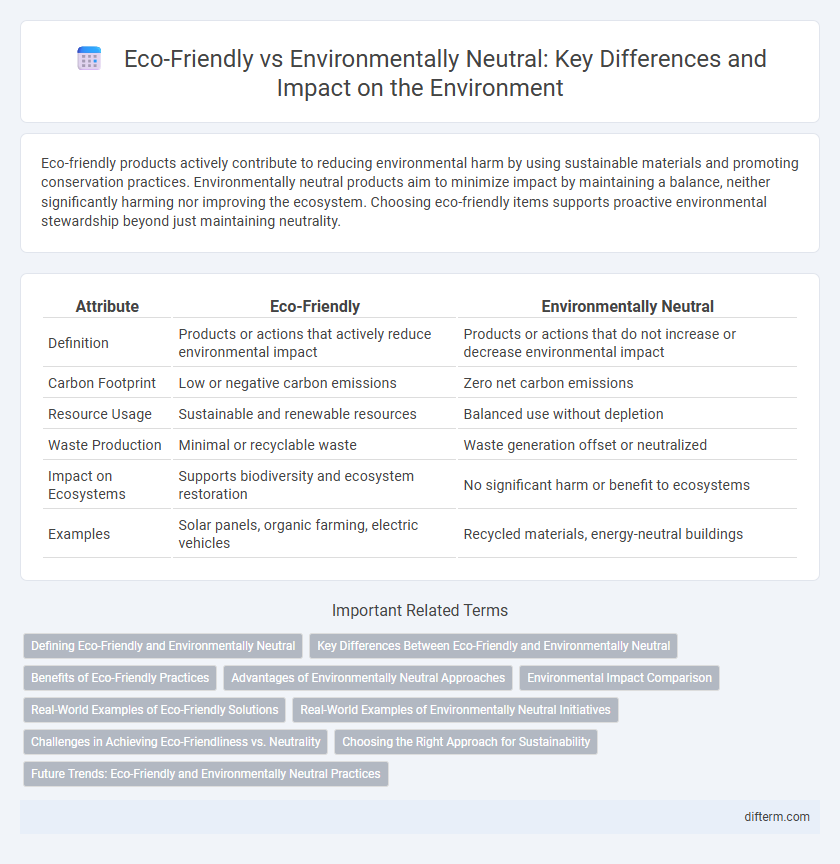Eco-friendly products actively contribute to reducing environmental harm by using sustainable materials and promoting conservation practices. Environmentally neutral products aim to minimize impact by maintaining a balance, neither significantly harming nor improving the ecosystem. Choosing eco-friendly items supports proactive environmental stewardship beyond just maintaining neutrality.
Table of Comparison
| Attribute | Eco-Friendly | Environmentally Neutral |
|---|---|---|
| Definition | Products or actions that actively reduce environmental impact | Products or actions that do not increase or decrease environmental impact |
| Carbon Footprint | Low or negative carbon emissions | Zero net carbon emissions |
| Resource Usage | Sustainable and renewable resources | Balanced use without depletion |
| Waste Production | Minimal or recyclable waste | Waste generation offset or neutralized |
| Impact on Ecosystems | Supports biodiversity and ecosystem restoration | No significant harm or benefit to ecosystems |
| Examples | Solar panels, organic farming, electric vehicles | Recycled materials, energy-neutral buildings |
Defining Eco-Friendly and Environmentally Neutral
Eco-friendly products actively reduce harm to the environment by using sustainable materials and minimizing pollution during production and disposal. Environmentally neutral items have little to no impact on the ecosystem, often achieved through balanced resource use and carbon offsetting. Distinguishing between these terms helps consumers make informed choices that support conservation and climate goals.
Key Differences Between Eco-Friendly and Environmentally Neutral
Eco-friendly products actively reduce environmental harm through sustainable materials and low emissions, whereas environmentally neutral items aim to balance their impact by offsetting emissions without necessarily lowering them. Eco-friendly practices prioritize biodiversity preservation and resource conservation, while environmentally neutral approaches focus on achieving net-zero impact through carbon offsets or remediation. Understanding these distinctions is crucial for making informed decisions that support genuine ecological sustainability.
Benefits of Eco-Friendly Practices
Eco-friendly practices actively reduce environmental harm by minimizing waste, lowering carbon emissions, and conserving natural resources, creating a positive impact on ecosystems. These practices promote sustainable development and enhance biodiversity, contributing to healthier air, water, and soil quality. In contrast, environmentally neutral actions merely avoid causing additional damage without generating significant ecological benefits or improvements.
Advantages of Environmentally Neutral Approaches
Environmentally neutral approaches minimize ecological footprints by balancing resource consumption and waste production without depleting natural systems, ensuring sustainability over time. These methods often require fewer resources and less energy compared to fully eco-friendly alternatives, making them more scalable and cost-effective for industries. Emphasizing neutrality reduces environmental impact while supporting economic growth and technological advancement.
Environmental Impact Comparison
Eco-friendly products actively reduce pollution and conserve natural resources, resulting in a lower carbon footprint and decreased environmental degradation. Environmentally neutral items aim to maintain the current state by minimizing negative effects without significant restoration or improvement. Comparing their environmental impact highlights that eco-friendly choices contribute to sustainability, while environmentally neutral options primarily seek to avoid further harm.
Real-World Examples of Eco-Friendly Solutions
Solar panels exemplify eco-friendly solutions by generating renewable energy and significantly reducing carbon footprints compared to conventional fossil fuels. Businesses adopting biodegradable packaging demonstrate a commitment to minimizing waste and environmental impact, contrasting with environmentally neutral options that aim to maintain current ecological states without improvement. Urban green spaces like community gardens improve air quality and biodiversity, showcasing proactive eco-friendly initiatives beyond mere environmental neutrality.
Real-World Examples of Environmentally Neutral Initiatives
Environmentally neutral initiatives like carbon offset programs at tech companies such as Microsoft and Google demonstrate effective balance by neutralizing emissions through reforestation and renewable energy investments without reducing overall environmental impact. Urban developments in cities like Copenhagen implement green roofs and energy-efficient buildings that maintain ecological stability while supporting urban growth. These real-world examples highlight practical approaches to achieving environmental neutrality, emphasizing mitigation over elimination of ecological footprints.
Challenges in Achieving Eco-Friendliness vs. Neutrality
Achieving eco-friendliness demands significant innovation in sustainable materials and renewable energy adoption, often facing technological and economic barriers. Environmentally neutral practices focus on balancing emissions through offsetting, yet struggle with accurately measuring and verifying carbon footprints. Both approaches confront regulatory challenges and the complexity of integrating eco-conscious solutions into existing industrial frameworks.
Choosing the Right Approach for Sustainability
Eco-friendly practices actively reduce environmental impact by using renewable resources and minimizing waste, contributing to biodiversity conservation and climate change mitigation. Environmentally neutral approaches aim to balance emissions and resource use through offsetting, maintaining current ecological footprints without further harm. Selecting the appropriate sustainability strategy depends on organizational goals, resource availability, and long-term environmental commitments.
Future Trends: Eco-Friendly and Environmentally Neutral Practices
Future trends in environmental sustainability emphasize a shift toward eco-friendly practices that actively reduce carbon footprints through renewable energy use and waste minimization. Environmentally neutral approaches focus on balancing emissions with offset initiatives such as carbon capture and reforestation projects. Increasing adoption of green technologies and circular economy models is expected to dominate environmental strategies by 2030.
eco-friendly vs environmentally neutral Infographic

 difterm.com
difterm.com